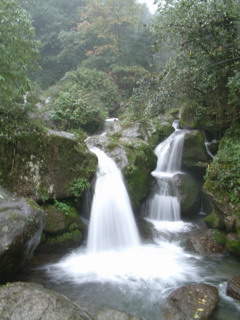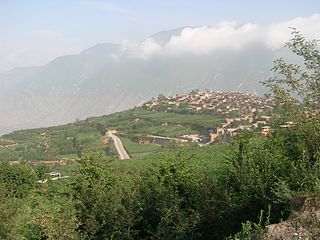
The Wudang Mountains consist of a small mountain range in the northwestern part of Hubei, China, just south of Shiyan. They are home to a famous complex of Taoist temples and monasteries associated with the god Xuanwu. The Wudang Mountains are renowned for the practice of Tai chi and Taoism as the Taoist counterpart to the Shaolin Monastery, which is affiliated with Chinese Chán Buddhism. The Wudang Mountains are one of the "Four Sacred Mountains of Taoism" in China, an important destination for Taoist pilgrimages.

Mount Emei is a mountain in Sichuan Province, China, and is one of the Four Sacred Buddhist Mountains of China. Mt. Emei sits at the western rim of the Sichuan Basin. The mountains west of it are known as Daxiangling. A large surrounding area of countryside is geologically known as the Permian Emeishan Large Igneous Province, a large igneous province generated by the Emeishan Traps volcanic eruptions during the Permian Period. At 3,099 metres (10,167 ft), Mt. Emei is the highest of the Four Sacred Buddhist Mountains of China.

Mount Gongga, also known as Minya Konka, is the highest mountain in Sichuan province, China. It is also known to locals as "The King of Sichuan Mountains". Situated in the Daxue Shan mountain range, between Dadu River and Yalong River, part of the Hengduan mountainous region, Mount Gongga is the easternmost 7,000 metres (23,000 ft) peak in the world and the third highest peak outside the Himalaya/Karakoram, after Tirich Mir and Kongur Tagh.

Mount Qingcheng is a mountain in Dujiangyan, Sichuan, China. It is considered one of the birthplaces of Taoism (Daoism) and one of the most important Taoist centres in China. In Taoist mythology, it was the site of the Yellow Emperor's studies with Ning Fengzi. As a centre of the Taoist religion it became host to many temples. The mountain has 36 peaks. It is home to Dujiangyan Giant Panda Center and is a UNESCO World Heritage Site. Mount Qingcheng was affected by the Wenchuan Earthquake in 2008.
Tianchi (天池) may refer to several locations in China:

Tai Shan is a giant panda born at the National Zoo in Washington D.C. on July 9, 2005 at 3:41 AM. He is the first panda cub born at the National Zoo to survive for more than a few days.

The Hengduan Mountains are a group of mountain ranges in southwest China that connect the southeast portions of the Tibetan Plateau with the Yunnan–Guizhou Plateau. The Hengduan Mountains are primarily large north-south mountain ranges that effectively separate lowlands in northern Myanmar from the lowlands of the Sichuan Basin. These ranges are characterized by significant vertical relief originating from the Indian subcontinent's collision with the Eurasian Plate, and further carved out by the major rivers draining the eastern Tibetan Plateau. These rivers, the Yangtze, Mekong, and Salween, are recognized today as the Three Parallel Rivers UNESCO World Heritage Site.

Biluochun is a famous green tea originally grown in the Dongting mountain region near Lake Tai, Jiangsu, China. Also known as Pi Lo Chun, it is renowned for its delicate appearance, fruity taste, floral aroma, showy white hairs and early cropping.
Lushan or Lu Shan is a famed mountain and World Heritage Site in Jiangxi, China.

The Longmenshan Fault is a thrust fault which runs along the base of the Longmen Mountains in Sichuan province in southwestern China. The strike of the fault plane is approximately NE. Motion on this fault is responsible for the uplift of the mountains relative to the lowlands of the Sichuan Basin to the east. Representing the eastern boundary of the Qinghai-Tibet Plateau, it is a border formation between the Bayan Kola block in the Plateau and the South China block in the Eurasian Plate. Both the 2008 Wenchuan earthquake and the 2013 Ya'an earthquake occurred along this fault.

The Longmen Mountains, also tautologically referred to in English-language publications as the Longmenshan Mountains, are a mountain range in Sichuan province in southwestern China.
Mount Tangjia is a mountain in Sichuan Province, China, 3.2 kilometres away from the county seat of Beichuan County.
Mengding Ganlu or Ganlu tea is a tea from Meng Mountain, Sichuan Province in the southwest part of China. Meng Shan is reputed to be the place where tea was first cultivated. Mengding Ganlu means "Sweet Dew of Mengding" where Mengding refers to "the top of Meng Shan".

Qionglai Mountains is a mountain range in the Sichuan Province of China. It runs in the general north-south direction, and is located mostly within the Ngawa Tibetan and Qiang Autonomous Prefecture, in the north-central part of the province.

The Daba Mountains, also known by their Chinese name as the Dabashan, are a mountain range in Central China between the watersheds of the Yellow and Yangtze Rivers. Part of the larger Qinling mountain range, it cuts through four provinces: Sichuan, Chongqing, Shaanxi, and Hubei. It is about 1,000 kilometers (620 mi) long.

Min Mountains or Minshan are a mountain range in central China. It runs in the general north-south direction through northern Sichuan and southernmost borderlands of Gansu. The highest elevation is Mount Xuebaoding, 5588 m and the second highest is Mt Little Xuebaoding, 5443m.

Hunhua Shan, also named Lincang Daxueshan 临沧大雪山, is a high mountain in Yunnan, China. It is located east of China National Highway 323, about 15 km to the northeast of Lincang.

The Phoenix Mountain Mosque is a mosque in Jinniu District, Chengdu, Sichuan Province, China.















